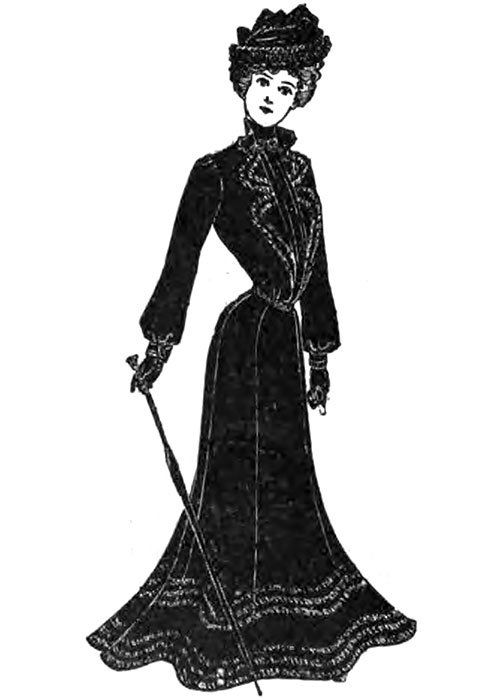Mourning Dress for Women - 1902

The first mourning dress for a widow consists of a black worsted skirt and waist, trimmed very simply with folds of gowns, continue to wear none but black dresses, with white muslin wrist and throat bands, black gloves, and purse; and use only a little jewelry, and that very simple.
The widow who purposes to leave off her mourning in due time wears a crepe bonnet and long veil and crepe—trimmed gowns a year. After this, black costumes of crepe de chine, lusterless silk. etc., are assumed, with hats and bonnets garnished with black ribbon and black flowers, black chiffon, and dull jet ornaments.
After six months, white and lilac touches may suitably relieve the second mourning; and after two years have expired, colors may be resumed.
A married woman wears, in mourning for her child, a sister, a brother, or a parent, just such dress as she wears in case of widowhood, except for the white bonnet ruché, which is the unmistakable insignia of widowhood.
She also wears her sable raiment one year at the least, though it is in better taste to assume second mourning after a year and a half, and not to go completely into colors until two years.
For infants, mourning is by some profoundly sorrowing mothers not worn at all, and where the bereaved parent is blessed with other young children, it is kindest to them to wear as little funeral black as possible.
A baby boy or girl may be suitably mourned for in pure black, without crepe, relieved with white, and lilac, or in soft gray.
Black without crêpe for one month is the suitable mourning in case of the death of a mother-in-law or a father-in-law: the crêpe is put off, and white is introduced with the black, and lilac is worn; and in second mourning, in the summer season, young women may appropriately wear white with mourning ribbons.
Middle-aged unmarried women in mourning for parents or sisters and brothers, wear just what a married woman wears in mourning for any of these relatives, and for the same time.
In mourning for an aunt, an uncle, or a grandparent, pure black without a touch of crepe, worn for three months, is the rule. Ordinary jewelry that is not conspicuous may be worn with this dress.
For a first cousin, simple black, worn for three weeks' mourning, is sufficient, though few persons wear black for after the first month, two or three weeks of black and white or gray, brightened with lilac, should follow.
Mourning is not often worn for brothers-in-law, sisters-in-law, aunts-in-law, or uncles-in-law, nor for a husband's grandparents.
A young unmarried woman should not wear a black bonnet and veil in mourning for her parents, or for a sister or a brother. In either of these cases, a hat trimmed wholly with crepe and a small face veil of plain black net with a broad border of crepe, a worsted gown trimmed with folds of crepe, black gloves, handkerchiefs with delicate ornamental black borders, and dull jet ornaments, or, better, none at all, make the proper costume for the first six months or year, after that, cousins.
Indeed, to assume crepe after the death of any but members of one’s immediate family is a foolish and conspicuous exaggeration of a hypocritical grief, unless the uncle, aunt, grandparent, or cousin has lived in near and dear association with the mourner, who experiences all the pain of losing one who was as beloved as a parent, sister, or brother. Then the mourning is worn as deep and for as long a time as for the nearest relative.
It is not wise nor in good taste to put children under fifteen years of age in mourning, and no girl under seventeen should wear crêpe. On the death of a parent, a sister, or a brother, a young girl wears a black felt or black straw hat, trimmed only with bows of lusterless ribbon.
Her dress should be black, touched with white about the waist. She should wear no jewelry of any kind, but she does not carry a black-bordered handkerchief.
Banks, Charles Eugene, Beautiful Homes and Social Customs of America: The Blue Book of American Culture, Chicago: The Bible House, Publishers, 1902, p. 306-308.
The illustration is from "Mourning Styles and Customs: Mourning Costume MC7", in the Delineator, Paris-London-New York: The Butterick Publishing Co. Ltd., Vol. LVII, No. 5, May 1901.
Editor's Note: Some terminology used in the description of women's clothing during the 1800s and early 1900s has been changed to reflect more modern terms. For example, a women's "Toilette" -- a form of costume or outfit has an entirely different common meaning in the 21st century. Typical terms applied to "toilette" include outfit, ensemble, or costume, depending on context.
Note: We have edited this text to correct grammatical errors and improve word choice to clarify the article for today’s readers. Changes made are typically minor, and we often left passive text “as is.” Those who need to quote the article directly should verify any changes by reviewing the original material.

